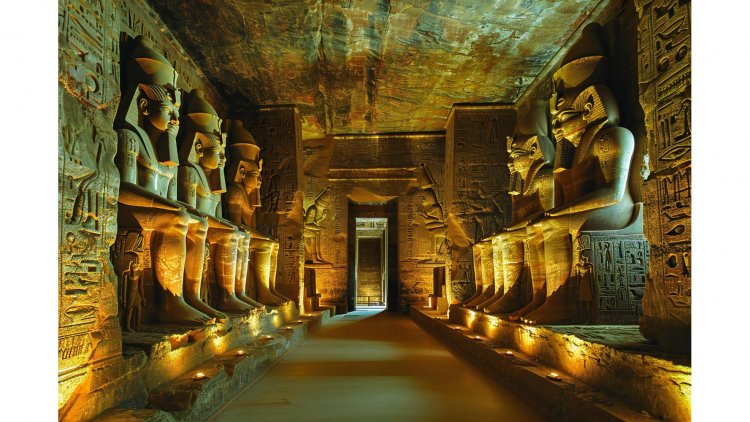Cairo's Timeless Treasures: A Journey Through Its Most Fascinating Museums
Cairo, Egypt's bustling capital, is a city where ancient history and modernity collide. This dynamic urban landscape offers an extraordinary array of museums, each preserving and celebrating the rich tapestry of Egypt’s storied past. From the grand displays of ancient artifacts to contemporary art exhibitions, Cairo's museums are a window into the country's soul. Embark on a journey through some of the most compelling museums Cairo has to offer.

The Egyptian Museum: Home of Pharaohs and Treasures
Unearthing Ancient Egypt
No visit to Cairo is complete without a pilgrimage to the Egyptian Museum, an institution synonymous with Egyptology. Located in Tahrir Square, the museum is a treasure trove of ancient artifacts, including the iconic Tutankhamun collection. This sprawling museum, housed in a grand early 20th-century building, showcases over 120,000 items, ranging from everyday objects to elaborate royal regalia.
Highlights and Exhibits
- Tutankhamun's Treasures: The museum’s centerpiece is undoubtedly the collection from the tomb of King Tutankhamun. This includes the famous gold mask, chariots, and a vast array of other artifacts that provide insight into the opulence of Egypt’s New Kingdom.
- Royal Mummies Room: This exhibit offers a chilling yet fascinating glimpse into the mummification process and features the mummies of some of Egypt’s most notable pharaohs.
- Statues and Stelae: The museum’s collection includes colossal statues of gods and pharaohs, along with intricately carved stelae that tell stories of ancient rituals and decrees.
Visiting Tips
The Egyptian Museum can be overwhelming due to its size and the sheer volume of exhibits. Consider taking a guided tour to make the most of your visit. Early morning visits are recommended to avoid the crowds and to enjoy a quieter experience.
The National Museum of Egyptian Civilization (NMEC): A Modern Marvel
Bridging the Past and Present
Inaugurated in 2021, the National Museum of Egyptian Civilization represents a new era in Egyptology. Located in Fustat, this museum offers a comprehensive overview of Egyptian history from prehistoric times to the present day. The NMEC is designed to present Egypt's cultural heritage in a way that is both informative and engaging.
Highlights and Exhibits
- The Royal Mummies Hall: This modern facility showcases 22 royal mummies, including those of Ramses II and Queen Hatshepsut. The mummies are displayed in a climate-controlled environment to preserve them for future generations.
- Everyday Life Exhibit: This exhibit focuses on the daily lives of ancient Egyptians, featuring artifacts from various periods that illustrate how people lived, worked, and celebrated life.
- Cultural Heritage Section: The NMEC places significant emphasis on the continuity of Egyptian culture, presenting artifacts that link ancient traditions with contemporary practices.
Visiting Tips
The NMEC is relatively new, which means it often has fewer visitors than older institutions. This makes it a great option for those looking to explore Egypt’s history in a more relaxed setting. Check out their website for information on special exhibitions and events.
The Coptic Museum: A Sanctuary of Christian Art
Discovering Egypt's Christian Legacy
Situated in Old Cairo, the Coptic Museum offers a deep dive into the Christian heritage of Egypt. The museum's collection spans the early Christian period through the Islamic era, showcasing a rich array of Coptic art and artifacts.
Highlights and Exhibits
- Coptic Artifacts: The museum houses a collection of ancient Coptic textiles, icons, and manuscripts that highlight the artistic achievements of Egypt's Christian community.
- Church Architecture Models: Models and relics from historic Coptic churches provide insight into the architectural styles and religious practices of early Christians in Egypt.
- Manuscript Collection: The museum features an impressive collection of illuminated manuscripts that offer a glimpse into early Christian scholarship and art.
Visiting Tips
The Coptic Museum is located in a historically rich area, so it's worth exploring the nearby Hanging Church and other Coptic sites. Guided tours can enhance the experience by providing context and historical background to the exhibits.
The Museum of Islamic Art: An Ode to Islamic Heritage
Celebrating Islamic Art and Culture
The Museum of Islamic Art, situated in downtown Cairo, is one of the world’s most important collections of Islamic art. It spans over 1,400 years of history and includes artifacts from Spain to India, reflecting the diverse nature of Islamic culture.
Highlights and Exhibits
- Calligraphy and Manuscripts: The museum boasts a significant collection of Islamic calligraphy and manuscripts, showcasing the evolution of written art in the Islamic world.
- Ceramics and Metalwork: Intricate ceramics and metalwork pieces from various periods highlight the technical and artistic achievements of Islamic artisans.
- Textiles and Jewelry: The museum also features beautiful textiles and jewelry that reflect the elegance and craftsmanship of Islamic fashion and adornment.
Visiting Tips
The Museum of Islamic Art is a must-visit for those interested in Islamic culture and history. The museum’s architecture is also noteworthy, with its design reflecting traditional Islamic aesthetics. Early morning visits or weekdays can offer a more peaceful experience.
The museums of Cairo are more than just repositories of artifacts; they are vibrant spaces where history comes alive. Whether you are an avid history buff, an art enthusiast, or simply a curious traveler, Cairo’s museums offer a wealth of experiences that bring Egypt’s past to the present. As you traverse through these cultural landmarks, you will gain a deeper appreciation of the rich and diverse heritage that has shaped one of the world’s most influential civilizations.
The Contemporary Cairo Museum: Art in the Modern Age
A Fresh Perspective on Modern Art
The Contemporary Cairo Museum, located in the bustling neighborhood of Zamalek, is a beacon of modern artistic expression in Egypt. Unlike traditional museums, it focuses on contemporary art and serves as a platform for emerging Egyptian artists to showcase their work.
Highlights and Exhibits
- Modern Art Collections: The museum’s collection includes a diverse range of modern and contemporary artworks, from paintings and sculptures to installations and digital media.
- Artist Residencies: The museum often hosts artist residencies and exhibitions that allow visitors to interact with contemporary artists and gain insights into their creative processes.
- Cultural Events: Regular workshops, talks, and cultural events are organized to foster dialogue and engagement with contemporary art.
Visiting Tips
The Contemporary Cairo Museum is ideal for those interested in the current art scene. Check their calendar for upcoming exhibitions and events to enhance your visit. The museum’s modern design and interactive exhibits offer a refreshing contrast to more traditional museum experiences.
The Gayer-Anderson Museum: A Glimpse into Ottoman Cairo
An Ottoman Gem in Historic Cairo
The Gayer-Anderson Museum, housed in a beautifully restored Ottoman-era house in the heart of Cairo, provides a unique glimpse into 17th-century Cairo. Named after the British doctor and collector Gayer-Anderson, who lived in the house, the museum is a showcase of Islamic and Ottoman art and architecture.
Highlights and Exhibits
- Ottoman Interiors: The museum’s rooms are furnished in traditional Ottoman style, offering a window into the domestic life of Cairo’s elite during the Ottoman period.
- Artifacts and Antiques: The collection includes a wide array of antiques, including textiles, ceramics, and brassware, which reflect the opulence of the era.
- Architectural Features: The house itself is a work of art, with intricate woodwork, stained glass windows, and elaborate tilework that exemplify Ottoman craftsmanship.
Visiting Tips
The Gayer-Anderson Museum is a hidden gem that often receives fewer visitors than larger institutions. Its intimate setting allows for a more personal exploration of Cairo’s Ottoman heritage. Guided tours can provide additional context and historical details.
The Cairo Opera House Museum: A Symphony of Culture
Celebrating Egypt’s Performing Arts
Located within the Cairo Opera House complex, the Cairo Opera House Museum is dedicated to Egypt’s rich musical and performing arts heritage. It offers insights into the evolution of Egypt’s theatrical and musical traditions.
Highlights and Exhibits
- Theatrical Costumes and Sets: The museum displays costumes, stage sets, and props from various productions, providing a behind-the-scenes look at the art of theater.
- Musical Instruments: A collection of traditional and modern musical instruments showcases the diversity of Egypt’s musical heritage.
- Performing Arts History: Exhibits highlight significant milestones in Egyptian performing arts, including influential figures and landmark performances.
Visiting Tips
The Cairo Opera House Museum is an excellent complement to a visit to a performance at the Cairo Opera House. Plan your visit around a show to experience both the museum and the vibrant performing arts scene.
The Ahmed Shawki Museum: Literature Meets Legacy
Honoring Egypt’s National Poet
The Ahmed Shawki Museum, located in the villa where the renowned Egyptian poet Ahmed Shawki lived, is a tribute to one of Egypt’s literary giants. The museum offers a glimpse into Shawki’s life and works, showcasing his contributions to Arabic literature.
Highlights and Exhibits
- Personal Artifacts: The museum’s collection includes Shawki’s personal belongings, manuscripts, and first editions of his works, providing a personal connection to the poet.
- Literary Works: Exhibits detail Shawki’s major literary achievements, including his poetry, plays, and contributions to modern Arabic literature.
- Historical Context: The museum also provides context on the cultural and political environment of Shawki’s time, enriching the visitor’s understanding of his work.
Visiting Tips
The Ahmed Shawki Museum is a must-visit for literature enthusiasts and those interested in the cultural history of Egypt. The museum’s setting in Shawki’s former residence adds an intimate touch to the experience.
The Agricultural Museum: Exploring Egypt’s Agrarian History
A Unique Agricultural Perspective
The Agricultural Museum in Cairo offers a unique perspective on Egypt’s agricultural history and its vital role in the country’s development. Located in the Dokki district, the museum is dedicated to showcasing the evolution of agricultural practices in Egypt.
Highlights and Exhibits
- Agricultural Tools and Machinery: The museum displays a range of historical and modern agricultural tools and machinery, illustrating the advancements in farming technology.
- Farm Models: Detailed models of traditional and modern farms offer insights into agricultural practices and their impact on Egyptian society.
- Cultural Exhibits: The museum also includes exhibits on the cultural significance of agriculture in Egypt, including festivals, rituals, and traditional farming practices.
Visiting Tips
The Agricultural Museum is a niche attraction but offers valuable insights into an often-overlooked aspect of Egyptian history. It’s especially interesting for those with a keen interest in agriculture or rural life.
Cairo's museums collectively form a rich mosaic of the city’s historical and cultural landscape. From the ancient wonders of the Egyptian Museum to the contemporary flair of the Contemporary Cairo Museum, each institution provides a unique lens through which to explore Egypt’s past and present. Whether you're delving into the ancient world, engaging with modern art, or discovering the nuances of Egypt’s literary and agricultural heritage, Cairo’s museums offer an unparalleled journey through time.
Disclaimer: The travel information and recommendations on this blog are intended for general guidance and inspiration. Conditions and regulations can change quickly, so please verify all details with appropriate sources before making travel plans. We are not liable for any errors, omissions, or outcomes resulting from your use of this information. Travel involves inherent risks, and it's essential to prioritize your safety and well-being. Always travel with adequate insurance and take necessary precautions.
What's Your Reaction?





















